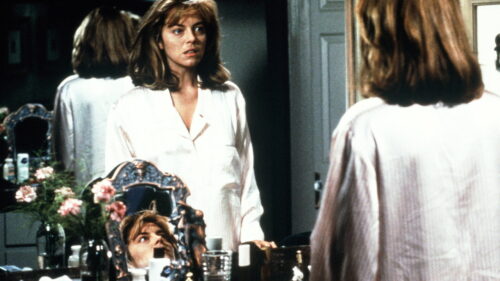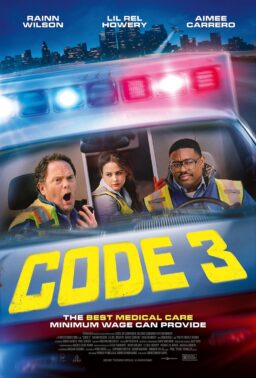On May 19, 2015, in midtown Manhattan, Bill Murray burst through the stage doors behind David Letterman’s studios during the taping of Letterman’s second-to-last show, clad in goggles and a jumpsuit, every square inch of him smeared with chunks of the giant cake he’d popped out of, then ran down the street and asked the crowd to follow him. Then he stood on Broadway and sang “All we are saying/Is more Worldwide Pants,” which is the name of Letterman’s production company, and asked everybody in earshot to sing along. And he held out his hands, inviting people to take his hand, to touch Bill Murray, to join with him.
And all around him, people took pictures and video. They had To Make Sure They Got This.
Murray was being trailed by a professional camera crew with professional sound equipment, and anybody who knew who Bill Murray was or why that particular location was significant would have known that the event was being amply covered, and they could see it on TV or YouTube soon, probably that very same night, looking and sounding better than whatever they could produce on the fly. But everyone still had to have their own personal record, even though in half of it you probably wouldn’t be able to tell what’s going on, with the camera swerving all over the place, recording the backs of other people’s heads as they, too, Made Sure They Got This: “Here’s video of Bill Murray in Times Square yesterday. The first 20 seconds you can’t really tell what’s going on because I’m running, but it gets a little better, and at the 45-second mark, you can kind of see his face.”
They took pictures of Murray as he burst through the doors. They continued taking pictures as he sprinted towards Times Square. Murray held out his hands as he ran, asking for high-fives; he got a few, but mostly from guys who first made sure they were capturing the moment on their phones. The more people Murray passed, the more phones got whipped out. I gotta call you back, Bill Murray just ran past me and asked me to sing with him, I gotta make sure I get this!
Bill Murray was essentially being followed by, and then surrounded by, cameras that happened to have people attached to them.
One guy reacted to cake-covered Bill Murray reaching out a hand to him by checking his cell phone, to make sure he was getting this, and then reciprocated.
We’ve become a one-handed species. We keep one hand in reserve for taking out a wallet, digging in a purse, swiping a Metrocard, helping up a person who’s fallen on the sidewalk, whatever. The other hand is for Making Sure We Got This.
Vine or it didn’t happen. Pictures or it didn’t happen. Video or it didn’t happen. We say that as a joke, but it’s not a joke. Unless we generated a picture or video clip that we can share, life might as well have not happened to us.
That’s why YouTube is filled with puzzling cell phone videos by people at concerts. In a lot of them, the camera is shaky and partly obscured by other people’s heads, and the audio might as well be coming from a monaural tape recorder sewn into a pillow. What is the point? To remind yourself what it felt like to stare at a cell phone for an hour and check the battery?
You see this sort of thing at fireworks displays. You see it in department stores and grocery stores. You see it at parks and beaches and at children’s recitals: digital screens pulsing, each blob of light marking a person who is not looking and listening at the thing in front of them with deep concentration, but instead devoting part of their senses to monitoring the technology they are using as an intermediary, often producing, when all is said and done, an inferior mnemonic record, with a poor image and sound.
I didn’t realize how pervasive the “I gotta get this!” mentality had become until I went to Ground Zero in 2011 to see how people were reacting to the news that Osama bin Laden had been killed. The crowd seemed to consist of about ten percent people who were actively participating in some way: drinking, unfurling flags, trading stories about what downtown Manhattan was like on 9/11. The other ninety were there to take pictures and video of the ten.
I know, I know. This has been going on for a few years. It’s not a news flash; it’s who we are as a species. I’m Grandpa Abe Simpson yammering about onion belts. I should climb onto the ice floe and shove off. Or say, “Oh yeah, things change, technology changes, it’s no big deal” and quit complaining.
But I think it deserves ongoing consideration and argument, because it’s everywhere.
Is it merely different from, but in no way inferior to, older forms of participation, as people who are addicted to doing it tend to claim when they read pieces like this one? I have no idea. Only a cognitive researcher could say with any authority. But it’s a major and visible change. It’s species-wide.
And I’ve personally not heard any convincing arguments against the idea that it means we have become, in some basic way, detached from our own existence; that life itself is becoming a supplier of material for Instagram, Flicker, Twitter, YouTube, Facebook and the like, rather than a thing that happens to us, and that we absorb with our bodies and minds, not with our phones.
Even when Bill Murray comes running down the street covered in cake, our first impulse is to make sure that we’re getting this. He reaches out a hand and we make sure we’re getting this.
Getting what?
About twenty minutes prior to that, just after Murray made his entrance via the giant cake, he went down into the audience to mingle with people. One of them was a woman who kissed him and got cake on her face. This can’t be held up as a counter-example of I Gotta Get This, because audiences at TV tapings are told to turn their recording devices off.
But I hope she saved a bit of the cake.












